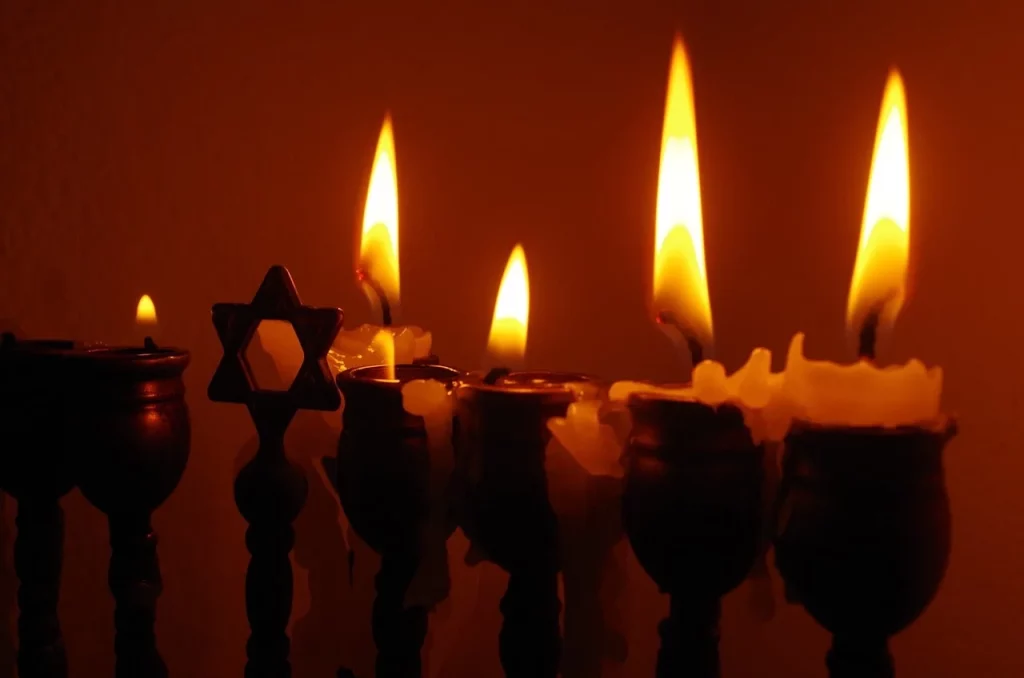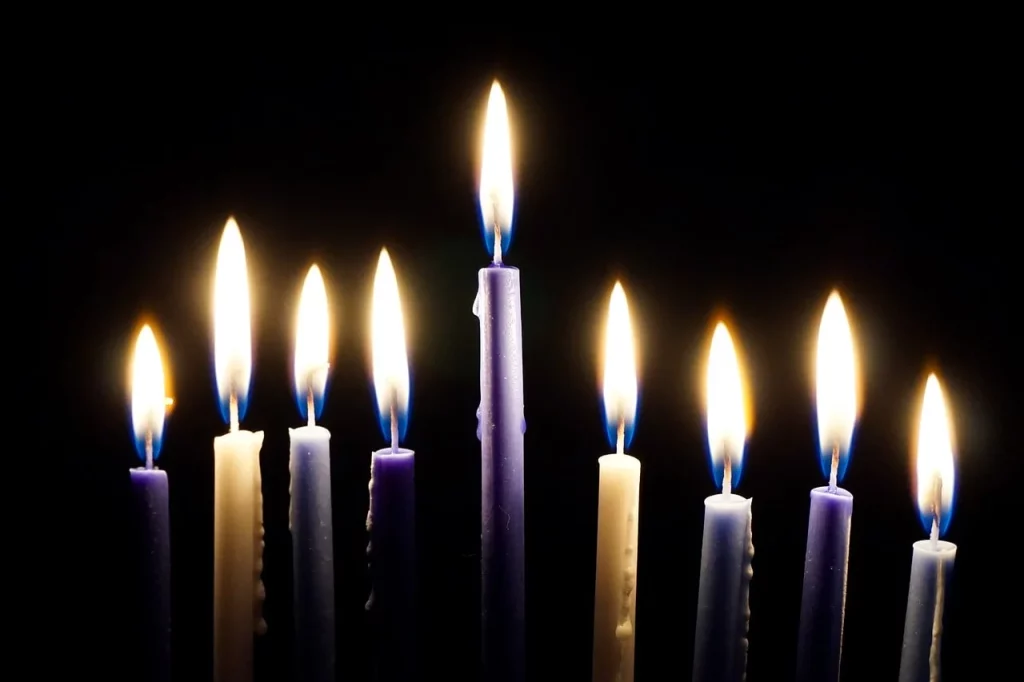Have you ever wondered why Hanukkah is celebrated for eight nights or why candles are such a central part of the festivities? Hanukkah, also known as the Festival of Lights, is a time filled with joy, reflection, and deep historical significance.
This article will take you on a journey through some fascinating facts about Hanukkah, shedding light on its traditions, history, and the reasons it holds a special place in the hearts of millions around the world. Get ready to discover the wonders and miracles that make it a cherished holiday.
The darkness of the whole world cannot swallow the glowing of a candle.
Robert Altinger
Hanukkah Facts
Before we dive into these interesting facts about Hanukkah, it’s important to note that a quiz awaits at the end of this article. Pay close attention to every detail shared if you aim to prove your expertise on this topic.
- The celebration spans eight nights to commemorate the oil that miraculously burned for an extended period of time.
- Potato pancakes, known as latkes, are consumed to signify the oil’s importance during this time.
- A four-sided top called a dreidel is played with, bearing Hebrew initials that translate to “A great miracle occurred there.”
- In the land of Israel, those same letters on the dreidel signify, “A great miracle occurred right here.”
- This period is also called the Festival of Lights due to the ceremonial illumination.
- The special candelabrum used has nine branches, accommodating one light for each night plus an additional helper light.
- Exchanging gifts has become a contemporary part of the festivities, though it was not originally part of the tradition.
- The historical backdrop is the Maccabean Revolt in the 2nd century BCE.
- The 1950s in America saw a resurgence in the observance as part of a broader Jewish cultural renaissance.
- New York City boasts the world’s largest menorah, reaching a height of 32 feet.
- Jelly doughnuts, or sufganiyot, symbolize the oil miracle as well and are a festive treat.
- The New Testament references the holiday in the context of Jesus’s visit to the Temple in the Book of John.
- Children traditionally receive Hanukkah money, known as gelt.

- The initial White House Hanukkah celebration was held by President Jimmy Carter in 1979.
- Studying Torah in secret under oppressive rule is remembered through playing dreidel.
- Songs and hymns, especially “Ma’oz Tzur,” are integral to the holiday’s observance.
- Placing the menorah by the home’s entrance, outside and to the left, is the ideal practice.
- “Dedication” in Hebrew points to the rededication of the Holy Temple, the event at the heart of the celebration.
- Legends suggest the oil miracle story was a later addition to the holiday’s historical account.
- Modern celebrations include public menorah lighting events to express Jewish pride and visibility.
- All eight candles are lit one by one across the nights, using the servant candle for this task.
- Coins minted by the Maccabees serve as archaeological evidence of their rebellion.
- A unique genre of music and parodies enriches the holiday’s cultural expressions.
- For public safety and convenience, artificial menorahs are utilized at large celebrations.
- The holiday’s timing varies, occurring from late November to late December.
- Eating dairy products during the festivities honors Judith’s courageous act.
- Learning about the holiday’s history and significance is a shared family activity.
- Charitable giving each day reflects the themes of hope and rejuvenation central to the holiday.

- The Books of the Maccabees, where the story is detailed, are external to the Hebrew Bible.
- The United States Postal Service issues Hanukkah stamps to honor the holiday’s cultural significance.
- The record for the largest dreidel stands at almost 18 feet in height.
- Creativity is showcased through menorahs crafted from unexpected materials.
- A week’s pay is sometimes given as gelt in certain traditions.
- Portable menorahs cater to those celebrating while traveling.
- Environmentally friendly menorahs have gained popularity, using sustainable materials for candles.
- Individuals from diverse backgrounds join in public menorah lighting ceremonies.
- The holiday underscores the fight for religious freedom and against tyranny.
- Jewish space travelers have observed Hanukkah in orbit, utilizing virtual menorahs.

- Special prayers, like the Hallel and Al HaNissim, are part of the ritual.
- Chocolate coins are a 20th-century innovation for Hanukkah gelt.
- Children’s art activities often involve creating their own dreidels and menorahs.
- The accuracy of the traditional Hanukkah narrative is debated among some Jewish scholars.
- Each evening’s lighting is accompanied by blessings, expressing gratitude for the miracles.
- Menorah-inspired architectural designs reflect Jewish identity.
- Online celebrations enable families to observe the holiday together from afar.
- The “attendant” candle is employed to light the others, preserving the sanctity of the lights for remembrance.
- Hebrew schools frequently present plays and educational programs about the holiday.
- Oily foods commemorate the enduring oil miracle.
- Unique family traditions might include themed nights dedicated to acts of kindness, study, or family games.
- This time serves as a poignant reminder of the resilience and continuity of Jewish tradition and identity.
Hanukkah Myths

Facts are cool, but myths are magical. Dive into the fantastical stories that have swirled around Hanukkah for centuries, and see if you can spot the truth hidden within.
- Hanukkah is Solely about the Miracle of the Oil
Despite popular belief, it commemorates not just the miracle of the oil that lasted eight days but also the rededication of the Second Temple in Jerusalem. This victory over the Seleucid Empire is central to the holiday’s significance. - Hanukkah is the Jewish Christmas
Often, it’s mistakenly thought that it is the Jewish equivalent of Christmas due to its proximity on the calendar. However, Hanukkah’s significance is rooted in its historical and religious importance, celebrating Jewish resilience and freedom, independent of Christmas traditions. - The Menorah is the Main Symbol of Hanukkah
While the menorah is well-known, the specific candelabrum used during Hanukkah is actually a “hanukkiah,” designed with nine branches for candles. One branch is for the shamash (helper candle), and the others for each night’s candle, differing from the seven-branched menorah used in the Temple. - Hanukkah Gifts are a Long-standing Tradition
The giving of gifts has been seen by many as a longstanding tradition. However, this practice is relatively recent, influenced significantly by Christmas gift-giving customs. Traditionally, it was more about the lighting of the menorah, prayers, and the distribution of gelt (money). - Hanukkah Foods are the Same Everywhere
The assumption that Hanukkah foods are uniform worldwide is misleading. While latkes (potato pancakes) are widely recognized, Hanukkah cuisine varies by region. In some places, sufganiyot (jelly-filled doughnuts) are popular, reflecting the holiday’s emphasis on oil-fried foods, but the specifics can vary greatly from one community to another.
No products found.
Hanukkah Quotes

Let’s continue our journey with some quotes from notable figures. Feel free to share your favorite ones in the comments so I can add them to the list as well.
Hanukkah is about the spark of the divine in all of us made in God’s image.
Suzanne Fields
Suzanne Fields emphasizes the spiritual essence of Hanukkah, highlighting the divine spark within each individual.
Just as a candle cannot burn without fire, men cannot live without a spiritual life.
Buddha
Although not directly about Hanukkah, this quote by Buddha captures the festival’s essence, emphasizing the importance of spirituality in life, akin to the light of Hanukkah candles.
We light candles in testament that faith makes miracles possible.
Nachum Braverman
Nachum Braverman eloquently speaks to the faith and miracles at the heart of Hanukkah, where lighting candles is a physical manifestation of spiritual beliefs.
Hanukkah teaches us how to survive exile and how to illuminate the darkness.
Nathan Englander
Nathan Englander offers insight into the deeper meaning of Hanukkah, focusing on resilience and bringing light to dark times, reflective of the Jewish experience.
Blessed is the match consumed in kindling flame.
Hannah Senesh
Hannah Senesh’s words resonate with the Hanukkah spirit, celebrating the sacrifice and strength found in the act of kindling light, symbolic of hope and perseverance.
Hanukkah FAQ

Intrigued by the quotes? Still have questions about Hanukkah traditions, history, or symbolism? Dive into the FAQ section for clear answers and deeper understanding.
- How is Hanukkah celebrated?
It is celebrated with the lighting of the menorah, a nine-branched candelabrum. On each of the holiday’s eight nights, a new candle is lit by the ninth, the shamash (“helper” or “attendant“), after sundown. The lighting is accompanied by prayers and is often followed by singing traditional songs, such as “Ma’oz Tzur.” Families also enjoy playing the dreidel game, exchanging gifts, and indulging in foods fried in oil, like latkes (potato pancakes) and sufganiyot (jelly-filled donuts), to commemorate the miracle of the oil. - Are Hanukkah candles lit from right to left?
Yes, Hanukkah candles are placed in the menorah from right to left, mirroring the way Hebrew is read, but they are lit from left to right. This means the newest candle is lit first each night. By doing this, we honor the newest addition to the celebration, highlighting the growth of light and joy throughout the eight days of Hanukkah. - Why can’t Hanukkah begin on Tuesday?
The date is determined by the Hebrew calendar, which is lunar-based but adjusted to align with the solar seasons. It begins on the 25th of Kislev. The variability in the calendar, including leap months, prevents it from starting on the same weekday each year. However, due to the complexities of the Hebrew calendar’s calculations, including how months are set and leap years are added, Hanukkah’s start never falls on a Tuesday. This is a result of the fixed and cyclical nature of the Hebrew calendar, which ensures that certain holidays do not fall on or adjacent to the Sabbath, affecting preparations and observances. - What does Hanukkah mean?
The word “Hanukkah” means “dedication” in Hebrew. The festival commemorates the rededication of the Second Temple in Jerusalem during the second century B.C., following the victory of the Maccabees over the Syrian-Greek army. The name reflects the focus of the holiday: celebrating the reclaiming and rededication of the holy temple after it was defiled. - What does Hanukkah celebrate?
It celebrates the victory of the Maccabees, a small group of Jewish fighters, over the much larger Syrian-Greek army and the subsequent miracle of the temple’s menorah burning for eight days on a single day’s supply of oil. This event is seen as a symbol of the triumph of faith and the perseverance of the Jewish people, and the holiday is a joyous celebration of religious freedom and the miracles that can occur even in the face of overwhelming odds.
No products found.
Hanukkah Trivia

Welcome to our Hanukkah quiz! If you don’t light up the scoreboard with the correct answers, you might find yourself spinning faster than a dreidel in a tornado.
Conclusion
In closing, Hanukkah reminds us of the power of hope and the strength found in unity. This holiday, with its deep historical roots and joyous traditions, invites us to look beyond the surface and find the light within ourselves and others.
As we light each candle, let’s think about the miracles we wish to see in the world and how we can be a part of them. Hanukkah isn’t just a story from long ago; it’s a living, breathing invitation to create light and warmth in our communities.
Till next time, stay curious. Cheers.
2 Sources Used For This Article

